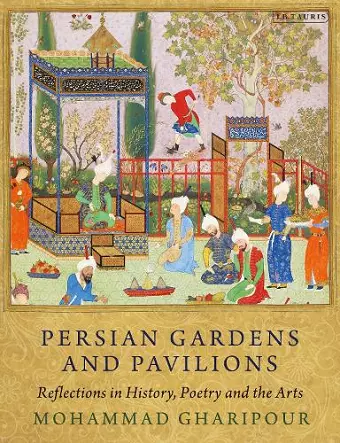Persian Gardens and Pavilions
Reflections in History, Poetry and the Arts
Format:Paperback
Publisher:Bloomsbury Publishing PLC
Published:9th Jul '20
Currently unavailable, and unfortunately no date known when it will be back

From Timur's tent in Samarqand to Shah Abbas' palace in Isfahan and Humayun's tomb in Delhi, the pavilion has been an integral part of Persianate gardens since the sixth century BC. This title explores the relationships between human beings and their domestic environments in Persian history.
From Timur's tent in Samarqand to Shah 'Abbas's palace in Isfahan and Humayun's tomb in Delhi, the pavilion has been an integral part of Persianate gardens since its earliest appearance at the Achaemenid garden in Pasargadae in the sixth century BC. Here, Mohammad Gharipour places both the garden and the pavilion within their historical, literary and artistic contexts, emphasizing the importance of the pavilion, which has hitherto been overlooked in the study of Iranian historical architecture. Starting with an examination of the depictions and representations of gardens in religious texts, Gharipour analyses how the idea of the garden developed from the model of pre-Islamic gardens in Achaemenid and Sassanian Persia to its mentions in the Zoroastrian text of Aban Yasht and on to its central role as paradise in the Qur'an. Continuing on with an exploration of gardens and pavilions in Persian poetry, Gharipour offers in-depth analysis of their literal and metaphorical values.
It is in the poetry of major Persian poets such as Ferdowsi, Naser Khosrow, Sa'di, Rumi and Hafez that Gharipour finds that whilst gardens are praised for their spiritual values, they also contain significant symbolic worth in terms of temporal wealth and power. Persian Gardens and Pavilions then goes onto examine the garden and the pavilion as reflected in Persian miniature painting, sculpture and carpets, as well as accounts of travelers to Persia. With masters such as Bizhad representing daily life as well as the more mystical prose and poetry in, for example, Sa'di's Bustan (The Orchard) and Golestan (The Rose Garden), the garden and the pavilion can be seen to have crucial semiotic significance and cultural meanings. But in addition to this, they also point to historical patterns of patronage and ownership which were of central importance in the diplomatic and social life of the royal courts of Persia. Gharipour thereby highlights the metaphorical, spiritual, symbolic and religious aspects of gardens, as well as their more materialistic and economic functions.
This book reaches back through Persia's rich history to explore the material and psychological relationships between human beings, pavilions and gardens, and will be a valuable resource for Art History, Architecture and Iranian Studies.
Mohammad Gharipour's fine book focuses on Persian gardens and the permanent or temporary structures within them, during the period from the fifteenth through the eighteenth centuries, but includes a useful concise survey of references to gardens in earlier literature stretching back to ancient Sumer, the Bible and the Qur'an. A scholarly book, it includes extensive apparatus of glossary, notes and sources, and 100 illustrations, many in color, generally of high quality and beautiful to study. It relies heavily on textual sources, including histories and poetry and travelers' accounts especially, and also pictorial sources, especially manuscript illuminations. Its wide scope seeks to set the garden in its social and historical context as a place for meetings and display and pleasure, as well as sometimes places of production. It goes beyond earlier treatments of the theme, including even color visualizations of Haravi's proposal for a "paradise" garden in the fifteenth century, and has systematic investigations of many questions, especially in regard to structures, such as tents, or thrones in gardens, and also discusses what can be said about the types and arrangements of plants." -- Lawrence Nees, university of Delaware * CHOICE *
Much has been written about Islamic gardens and Islamic architecture. Mohammad Gharipour usefully discusses the relationship between the two…the contents are clearly arranged. -- Caroline Stone * SAUDI ARAMCO WORLD (US) *
ISBN: 9780755600366
Dimensions: 246mm x 188mm x 18mm
Weight: 720g
256 pages